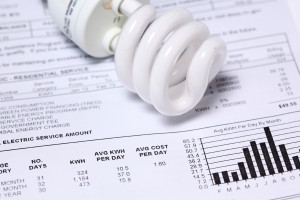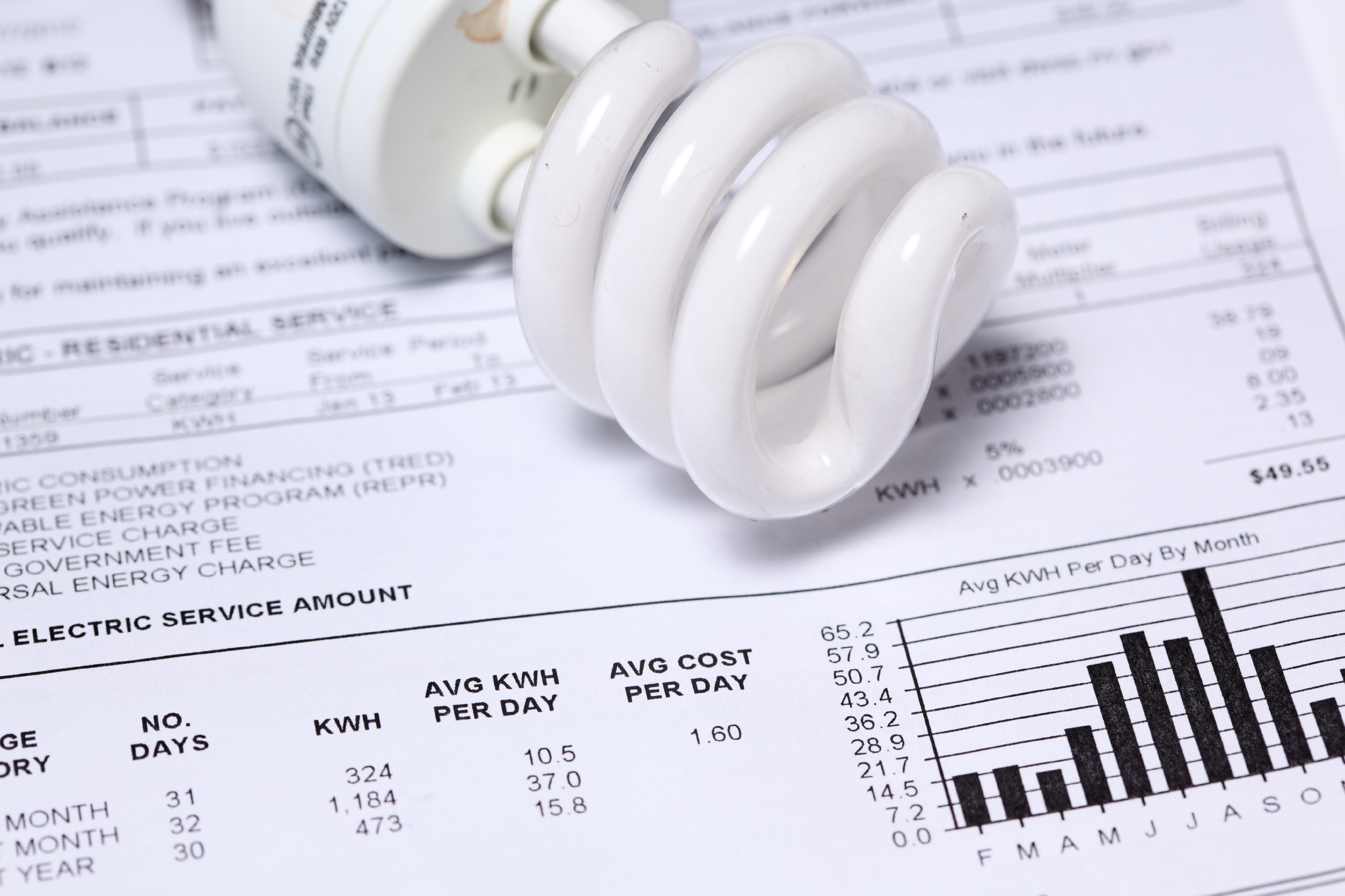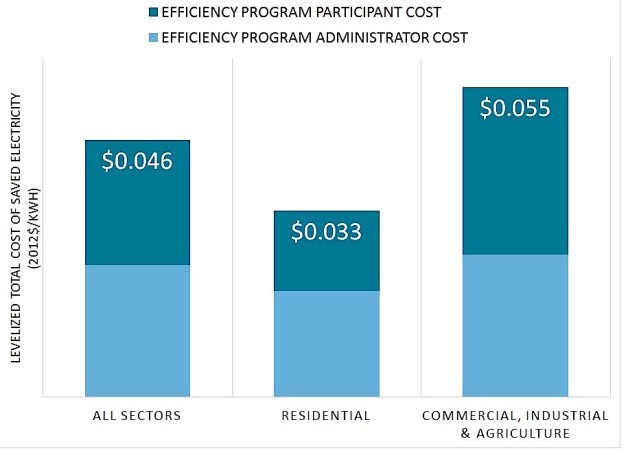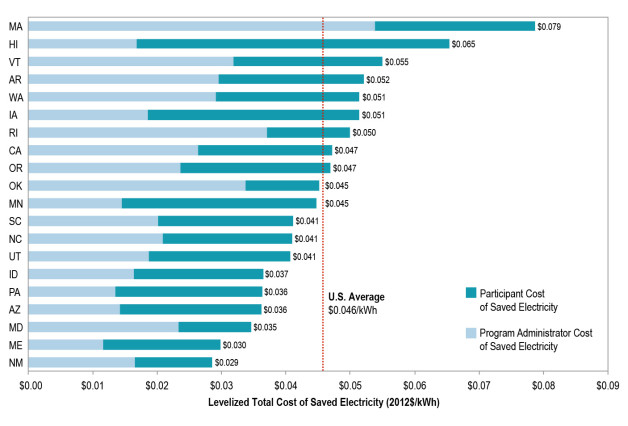What does it cost to save electricity?
Researchers at Lawrence Berkeley National Laboratory (Berkeley Lab) have conducted the most comprehensive study yet of the full cost of saving electricity by U.S. utility efficiency programs and now have an answer: 4.6 cents. That’s the average total cost of saving a kilowatt-hour in 20 states from 2009 to 2013, according to a Berkeley Lab report titled, The Total Cost of Saving Electricity Through Utility Customer-Funded Energy Efficiency Programs: Estimates at the National, State, Sector and Program Level, released today. To arrive at that average, researchers collected and analyzed several hundred regulatory documents filed in each state by utilities and other administrators of efficiency programs that are funded by utility customers.
“We’ve looked at total costs in more states and in more detail than previous studies,” said Chuck Goldman, principal investigator for the study and head of energy and environmental analysis at Berkeley Lab. “Our results suggest that the cost of energy efficiency still compares favorably to the cost of new energy supply and to retail electric rates.”
What it costs to save energy is especially important as states increasingly turn to efficiency programs to manage demands for electricity. Previous Berkeley Lab research suggests that annual spending of utility customer funds on efficiency programs may increase to $9.5 billion by 2025. Understanding how the cost of saving electricity varies across program types, and what influences such variations, can help improve the performance and cost effectiveness of programs as investment in them grows. Electric power system planners and states can use information on the cost of saving electricity to evaluate how best to meet future electric system needs and potential air emissions reductions.
Reliable estimation of the total cost of saving energy can be challenging. Fewer than half of states with efficiency programs require reporting of full costs at the program level, and quantification of costs to the program participant differs among program administrators. As a result, most national studies of efficiency program costs consider only the cost to the utility or other program administrator. For its study, Berkeley Lab collected and standardized the addition of participant costs.
“We now have a portrait of energy efficiency investments driven by utility programs,” said Ian Hoffman, lead author of the study. “We can see exactly where utilities and their customers are turning to save energy. We are beginning to see how those investments—and costs—are shifting over time to tap new markets, technologies and strategies, including the combined application of information and behavioral sciences to reduce energy use.”
Among the findings in the Berkeley Lab report released today:
- Efficiency programs and participants have split the cost of saving electricity almost right down the middle—on average paying roughly 2.3 cents per kilowatt-hour each (see Figure 1).
- The total cost of saved electricity was 3.3 cents per kWh in the residential sector in our sample of programs. Home lighting programs, with a cost of just 1.8 cents per kWh and accounting for nearly 60% of residential energy savings in the Berkeley Lab’s database, have helped drive costs down.
- Commercial and industrial programs (C&I) delivered energy savings at a total cost averaging 5.5 cents per kWh. Prescriptive C&I rebate programs (4.5 cents per kWh) and custom C&I rebate programs (5.2 cents per kWh) account for more than 60 percent of the savings in the non-residential sector.
- Utilities increasingly are turning to “home energy reports” mailed to households comparing their energy use with similar households, with motivational messages and customized tips to save energy. For these behavioral feedback programs, we found that the total cost of saved electricity averaged 5.7 cents per kilowatt hour, based in part on program administrators’ assumption that the energy savings last for one year. Recent studies suggest instead that the energy savings from behavioral changes may last longer. If savings were to last 3.9 years (a value recommended in a recent meta-analysis study), behavioral feedback programs would have saved electricity at a total cost of 1.7 cents per kWh.
- Cost performance among program types varied more in the residential sector than in the non-residential sectors, with the inter-quartile range differing by a factor of three to five among various types of residential programs and by a factor of two for most types of non-residential programs.
- The total cost of energy savings varies greatly from state to state (see Figure 2), and many factors influence the cost. For example, states and utilities that have pursued efficiency as an energy resource for years may have tapped some of their lowest cost sources of savings and now are targeting other end uses. States and utilities that are relatively new to energy efficiency may still have substantially untapped low-cost energy savings. States that pursue higher savings require greater market penetration, more savings per project, or both. These higher savings targets can cost more to achieve.Other co-authors on the paper are Gregory Rybka, Greg Leventis, Lisa Schwartz, Megan Billingsley, and Steven Schiller.Funding for this work comes primarily from the U.S. Department of Energy’s Office of Electricity Delivery and Energy Reliability, and the Office of Energy Policy and Systems Analysis.
# # #
Lawrence Berkeley National Laboratory addresses the world’s most urgent scientific challenges by advancing sustainable energy, protecting human health, creating new materials, and revealing the origin and fate of the universe. Founded in 1931, Berkeley Lab’s scientific expertise has been recognized with 13 Nobel prizes. The University of California manages Berkeley Lab for the U.S. Department of Energy’s Office of Science. For more, visit www.lbl.gov.
DOE’s Office of Science is the single largest supporter of basic research in the physical sciences in the United States, and is working to address some of the most pressing challenges of our time. For more information, please visit science.energy.gov.


